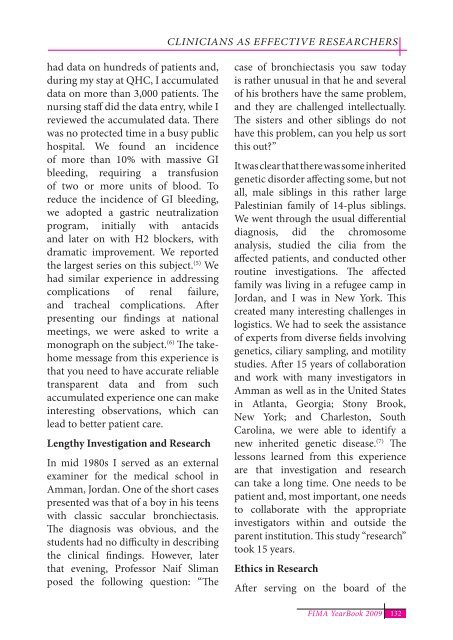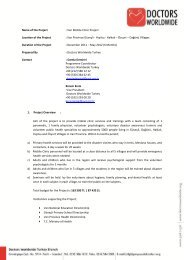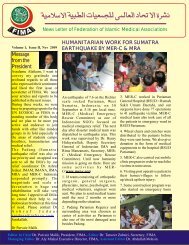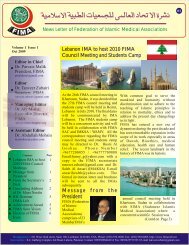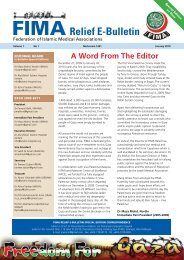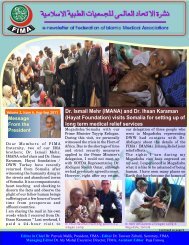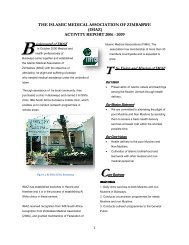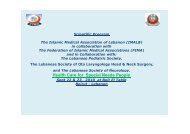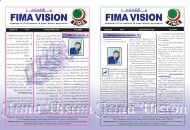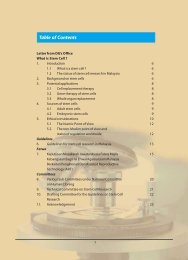FIMA Year Book 2009 - Federation of Islamic Medical Associations
FIMA Year Book 2009 - Federation of Islamic Medical Associations
FIMA Year Book 2009 - Federation of Islamic Medical Associations
You also want an ePaper? Increase the reach of your titles
YUMPU automatically turns print PDFs into web optimized ePapers that Google loves.
Clinicians As Effective Researchershad data on hundreds <strong>of</strong> patients and,during my stay at QHC, I accumulateddata on more than 3,000 patients. Thenursing staff did the data entry, while Ireviewed the accumulated data. Therewas no protected time in a busy publichospital. We found an incidence<strong>of</strong> more than 10% with massive GIbleeding, requiring a transfusion<strong>of</strong> two or more units <strong>of</strong> blood. Toreduce the incidence <strong>of</strong> GI bleeding,we adopted a gastric neutralizationprogram, initially with antacidsand later on with H2 blockers, withdramatic improvement. We reportedthe largest series on this subject. (5) Wehad similar experience in addressingcomplications <strong>of</strong> renal failure,and tracheal complications. Afterpresenting our findings at nationalmeetings, we were asked to write amonograph on the subject. (6) The takehomemessage from this experience isthat you need to have accurate reliabletransparent data and from suchaccumulated experience one can makeinteresting observations, which canlead to better patient care.Lengthy Investigation and ResearchIn mid 1980s I served as an externalexaminer for the medical school inAmman, Jordan. One <strong>of</strong> the short casespresented was that <strong>of</strong> a boy in his teenswith classic saccular bronchiectasis.The diagnosis was obvious, and thestudents had no difficulty in describingthe clinical findings. However, laterthat evening, Pr<strong>of</strong>essor Naif Slimanposed the following question: “Thecase <strong>of</strong> bronchiectasis you saw todayis rather unusual in that he and several<strong>of</strong> his brothers have the same problem,and they are challenged intellectually.The sisters and other siblings do nothave this problem, can you help us sortthis out?”It was clear that there was some inheritedgenetic disorder affecting some, but notall, male siblings in this rather largePalestinian family <strong>of</strong> 14-plus siblings.We went through the usual differentialdiagnosis, did the chromosomeanalysis, studied the cilia from theaffected patients, and conducted otherroutine investigations. The affectedfamily was living in a refugee camp inJordan, and I was in New York. Thiscreated many interesting challenges inlogistics. We had to seek the assistance<strong>of</strong> experts from diverse fields involvinggenetics, ciliary sampling, and motilitystudies. After 15 years <strong>of</strong> collaborationand work with many investigators inAmman as well as in the United Statesin Atlanta, Georgia; Stony Brook,New York; and Charleston, SouthCarolina, we were able to identify anew inherited genetic disease. (7) Thelessons learned from this experienceare that investigation and researchcan take a long time. One needs to bepatient and, most important, one needsto collaborate with the appropriateinvestigators within and outside theparent institution. This study “research”took 15 years.Ethics in ResearchAfter serving on the board <strong>of</strong> the<strong>FIMA</strong> <strong>Year</strong><strong>Book</strong> <strong>2009</strong>132


